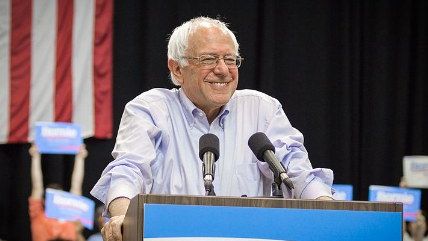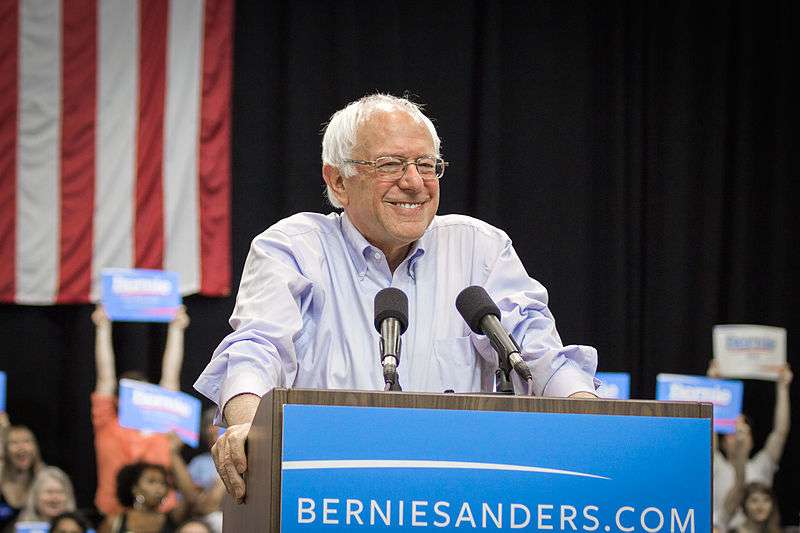Sanders Closing in on Clinton in California, But Poll Numbers May Not Mean Actual Votes
The Golden State's complex primary system may not benefit him, but the fight will help state-level Democrats.


Sen. Bernie Sanders has been holding rallies all over California to large crowds, even heading inland to smaller communities that tend to get ignored in favor of the largest cities.
California's primaries are on June 7, and while Hillary Clinton has been ahead in the polls in the state this whole time (sometimes with double-digit numbers), a new poll by the Public Policy Institute of California (PPIC) has Sanders closing to within striking distance. They have Clinton ahead by just two percentage points, 46 percent to 44 percent.
Clinton is winning with older and Latino Democratic voters. Sanders is winning with younger and "independent" voters. That Sanders is leading with independent voters may mean a problem for him, though. In California, for the presidential races, the parties themselves decide whether to allow non-party members to participate in the primaries. The Democratic Party does indeed permit voters who are not affiliated with any other party to vote for their presidential nominees. But voters have to actually request the Democratic Party's ballot. If they do not, they are sent a ballot that doesn't include the presidential race.
California has a fairly large mail-in ballot system, and votes are already coming in. KQED checked with an election analyst and discovered that an overwhelming percentage of independent voters did not request a Democratic ballot, meaning that they cannot cast a vote for Sanders (or Clinton) even if they want to:
"In Los Angeles County 91 percent of the ballots mailed to non-partisan voters had no presidential candidates on it," says [Paul] Mitchell. "And 85 percent of ballots sent statewide to non-partisan or independent voters have no presidential candidates on it."
There's still time for independent voters to request a Democratic ballot, and they can even do that at their polling place on Election Day. Still, the data suggest a lot of confusion out there with little time to fix it.
In April, the Los Angeles Times noted that huge numbers (likely in the tens or even hundreds of thousands) of self-described "independent" voters had actually registered as members of the conservative American Independent Party, and if they don't correct that mistake, they would also not be able to vote for Sanders or Clinton.
For Californians who aren't participating in the presidential primary, there are still the down-ballot candidates. But that's where the state's top-two ballot system kicks in. What that means is that on June 7, primary voters can cast votes for candidates for statewide or lower offices, and these votes are not bound to political parties. Each voter can choose a Democrat, a Republican, or even a Libertarian, without having to be members of the party. Then the top two vote-getters, regardless of their party affiliation, will face off in November. Essentially, the November election has become a run-off race for non-presidential candidates.
This means voters may end up with two candidates from the same political party as their only choices. This has happened in the past in districts where either the Democrats (in major cities) or the Republicans (in some inland communities) are the overwhelmingly dominant political force. And in this election, it may happen in the race to replace retiring Democratic Sen. Barbara Boxer. Right now the frontrunners for the Senate race are Attorney General Kamala Harris (a Democrat) and Rep. Loretta Sanchez (a Democrat). There are Republicans and Libertarians (and others) in pool of candidates for the primary vote in June, but if none of those candidates get more votes than either Harris or Sanchez, they will not appear on the November ballot. The only choice even the most conservative or independent of Californians may get is between two Democrats.
Now that Trump has secured the presidential nomination for the Republican Party, there's a reduced incentive for Republicans to vote in June. But if they aren't aware that the primary determines whether their party has representatives in the fall races at all, they're going to discover a November ballot full of candidates that have no interest in representing them. Welcome to the feeling of being in a third party, California members of the GOP. The PPIC poll found that 24 percent of Californians said they wouldn't even bother voting if the Senate race comes down to just two Democrats.
So Sanders remaining in the race against Clinton actually benefits Democratic candidates all the way down the ballot in California because of the increased voter turnout. No wonder Harris' ads stay out of the fray between the Sanders and Clinton entirely and instead focus on the support she's received from Sen. Elizabeth Warren.


Show Comments (98)